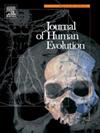持久的捕食者:舍宁根专门猎杀马匹的动物考古证据 13II-4
IF 3.1
1区 地球科学
Q1 ANTHROPOLOGY
引用次数: 0
摘要
舍宁根 13II-4 遗址是旧石器时代考古学的一个奇迹。舍宁根遗址保存了中更新世时期的完整木矛和屠宰的大型哺乳动物骨骼,在全球人类起源研究中占有重要地位。在这里,我们首次分析了舍宁根 13II-4 号遗址出土的完整大型哺乳动物化石组合,通过动物考古学和岩石学等多方面的证据,揭示了该遗址中人类在狩猎前、狩猎中和狩猎后的全部活动。马(Equus mosbachensis)遗骸在这些遗骸中占主导地位,表明舍宁根古湖边缘地区经常出现伏击狩猎策略。在这方面,舍宁根 13II-4 号考古发掘提供了第一个无可争议的证据,证明了在原地、露天环境下对单一猎物物种的狩猎。舍宁根古人类很可能依靠合作狩猎策略以马家族为目标,而几乎排除了单身马群。马的捕杀发生在一年四季,这意味着舍宁根地区全年都有人类活动。猎物骨骼的所有部分都出现在采集物中,其中许多骨骼完整且处于半关节化状态,很少有骨骼部分被运离遗址。屠宰痕迹非常多,成年猎物的尸体比幼年猎物处理得更彻底。大量完整、未经修饰的骨骼表明,瘦肉和骨髓并不总是那么珍贵,尤其是在涉及多次宰杀的事件中,脂肪和兽皮可能会受到更多关注。舍宁根的行为继续挑战我们对过去类人生活方式的看法和模式,进一步巩固了舍宁根作为了解欧洲中更新世狩猎适应性的典型的地位。本文章由计算机程序翻译,如有差异,请以英文原文为准。
Persistent predators: Zooarchaeological evidence for specialized horse hunting at Schöningen 13II-4
The Schöningen 13II-4 site is a marvel of Paleolithic archaeology. With the extraordinary preservation of complete wooden spears and butchered large mammal bones dating from the Middle Pleistocene, Schöningen maintains a prominent position in the halls of human origins worldwide. Here, we present the first analysis of the complete large mammal faunal assemblage from Schöningen 13II-4, drawing on multiple lines of zooarchaeological and taphonomic evidence to expose the full spectrum of hominin activities at the site—before, during, and after the hunt. Horse (Equus mosbachensis) remains dominate the assemblage and suggest a recurrent ambush hunting strategy along the margins of the Schöningen paleo-lake. In this regard, Schöningen 13II-4 provides the first undisputed evidence for hunting of a single prey species that can be studied from an in situ, open-air context. The Schöningen hominins likely relied on cooperative hunting strategy to target horse family groups, to the near exclusion of bachelor herds. Horse kills occurred during all seasons, implying a year-round presence of hominins on the Schöningen landscape. All portions of prey skeletons are represented in the assemblage, many complete and in semiarticulation, with little transport of skeletal parts away from the site. Butchery marks are abundant, and adult carcasses were processed more thoroughly than were juveniles. Numerous complete, unmodified bones indicated that lean meat and marrow were not always so highly prized, especially in events involving multiple kills when fat and animal hides may have received greater attention. The behaviors displayed at Schöningen continue to challenge our perceptions and models of past hominin lifeways, further cementing Schöningen's standing as the archetype for understanding hunting adaptations during the European Middle Pleistocene.
求助全文
通过发布文献求助,成功后即可免费获取论文全文。
去求助
来源期刊

Journal of Human Evolution
生物-进化生物学
CiteScore
6.30
自引率
15.60%
发文量
104
审稿时长
3 months
期刊介绍:
The Journal of Human Evolution concentrates on publishing the highest quality papers covering all aspects of human evolution. The central focus is aimed jointly at paleoanthropological work, covering human and primate fossils, and at comparative studies of living species, including both morphological and molecular evidence. These include descriptions of new discoveries, interpretative analyses of new and previously described material, and assessments of the phylogeny and paleobiology of primate species. Submissions should address issues and questions of broad interest in paleoanthropology.
 求助内容:
求助内容: 应助结果提醒方式:
应助结果提醒方式:


